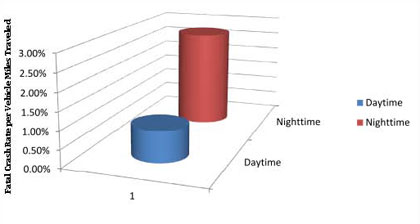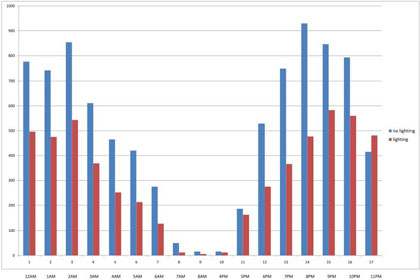This section discusses the references, policy, and recommendations used by the Federal Highway Administration in evaluating and administering funds for roadway and street lighting projects.
1 Purpose of Lighting
1.1 Purpose of Handbook
This handbook supplements the guidance provided by AASHTO and IES
This handbook has been prepared to provide guidance to lighting designers and State, city, and town officials concerning the design and application of roadway lighting. It is not intended to be a detailed design guide. It is primarily a resource for policy makers and the design and construction community to evaluate potential need, benefits, and applicable references when considering a roadway or street lighting system. Documents available from organizations such as the American Association of State Highway and Transportation Officials (AASHTO), the Illuminating Engineering Society (IES), and the Commission Internationale de l'Eclairage (CIE) offer recommendations on lighting levels, lighting configurations, and other considerations. This handbook directs users to that information where applicable, and provide supplemental information on topics not addressed in those documents.
The document is divided into six areas of discussion. These areas include:
Policy and Guidance – discussing references, policy, and recommendations used by FHWA in evaluating and administering funds for roadway and street lighting projects.
Basic Terms and Concepts – discussing descriptions of significant terms and concepts used in roadway and street lighting projects.
Warranting Criteria – including various warranting methods available when considering lighting.
Lighting Impacts – discussing various impacts (both positive and negative) of lighting systems and ways to control and mitigate.
Application Considerations – supplementing information provided in the reference documents.
Other Systems and Issues – discussing additional lighting and non-lighting elements impacting the roadway user.
This handbook is an update to the 1978 FHWA Lighting Handbook 78-15 as well as the 1983 addendum to chapter 6 of the handbook.
Key documents that provide guidance and criteria for roadway lighting and associated applications are listed below. The latest versions of these documents should be used as references for design projects.
- AASHTO GL-6 Roadway Lighting Design Guide (www.transportation.org)
- ANSI/IES RP-8 Standard Practice for Roadway Lighting (www.ies.org)
- ANSI/IES RP-22 Standard Practice for Tunnel Lighting (www.ies.org)
- ANSI/IES RP-22 Standard Practice for Tunnel Lighting (www.ies.org)
- IES DG-19 Design Guide for Roundabout Lighting (www.ies.org)
- FHWA-RD-01-103 Highway Design Handbook for Older Drivers and Pedestrians (www.fhwa.dot.gov)
- FHWA-SA-07-010 Railroad-Highway Grade Crossing Handbook (www.fhwa.dot.gov)
- FHWA-HRT-08-053 Informational Report on Lighting Design for Midblock Crosswalks (www.fhwa.dot.gov)
- TAC Guide for the Design of Roadway Lighting 2006 Edition (www.tac-atc.ca)
- NCHRP 672 Roundabouts: An Informational Guide – Second Edition (www.trb.org)
Additional useful documents include:
- AASHTO RSDG-3 Roadside Design Guide 4th Edition 2011 (www.transportation.org)
- AASHTO Highway Safety Manual (www.highwaysafetymanual.org)
- AASHTO A Policy on Geometric Design of Highways and Streets 6th Edition 2011 (www.transportation.org)

Figure 1a - Fatal Crash Rates per VMT for Day and Night (2009 FARS and NHTS data)
1.2 Purpose of Roadway and Street Lighting
Studies have shown a reduction in nighttime fatal crashes of up to 60% with the use of roadway lighting (5)
Driving or walking on, or across, a roadway is less safe in darkness than in a lighted area, due to the reduced visibility of hazards and pedestrians. Though the number of fatal crashes occurring in daylight is about the same as those that occur in darkness, only 25 percent of vehicle-miles traveled occur at night. Because of that the nighttime fatality rate is three times the daytime rate, as illustrated in Figure 1a. Figure 1b shows the difference in the number of fatal crashes on lit and unlit roadways.

Figure 1b - Fatal Crashes during Darkness by Lighting Condition (2009 FARS data)
On a fundamental level, driving is largely a visual task. Being able to adequately see the road/street ahead and observe conflicting traffic and the behavior of other highway users is integral to the driving task. Lighting significantly improves the visibility of the roadway, increases sight distance, and makes roadside obstacles more noticeable to the driver, and therefore more avoidable.
Roadway lighting is a proven safety countermeasure. The positive safety effects of lighting have been documented in various reports and publications. For example, an FHWA/AASHTO international scan documented (1) that many countries showed a 20 to 30 percent reduction in the number of crashes when lighting was installed. More recently, the FHWA Signalized Intersection Informational Guide (3) reported that adding lighting can reduce nighttime crashes by 50 percent and reduce fatal crashes by 43 percent. There have been many other studies that document similar safety benefits of lighting.
In addition to traffic safety, adequate lighting provides clear benefits in terms of personal security. Roadway lighting often serves the purpose of safeguarding personal safety for pedestrians, bicyclists, and transit users as they travel along and across roadways. Deep shadows or darkness reduce personal security, and walking, bicycling or commercial activities may become uncomfortable or unsafe. Thus, ensuring that the lighting provides minimum acceptable levels of illumination is of great importance to all users of a roadway environment.
Noteworthy research included as part of the FHWA CMF Clearinghouse discussing the effects of road lighting on safety and driver performance includes:
- Elvik and Vaa (2004)(4) reviewed 38 studies comparing the impact of lighting on previously unlit roads and found a 64 percent reduction of fatal crashes, 28 percent reduction in injury crashes, and 17 percent reduction in property-damage-only crashes after the roadways were lit.
- Per Ole Wanvik (2009)(5) used various study methods and literature review to determine the usefulness of road lighting as a countermeasure, and found that the mean effect of roadway lighting is a 28 percent reduction in injury crashes, a 60 percent reduction in fatal crashes, a 45percent reduction in injury crashes involving pedestrians, a 35 percent reduction in injury crashes at rural intersections, and a 50 percent reduction in injury crashes on freeways.
Other research of note include:
- Lipinski and Wortman (1976)(6) showed a 45 percent reduction in the night crash rate at rural at-grade intersections.
- Walker and Roberts (1976)(7) found a 52 percent reduction in nighttime crashes at 47 intersections in a 6-year before-and-after study.
- The Minnesota Local Road Research Board (2006)(8), comparing rural intersection locations before and after lighting had been installed, indicated that 44 percent of the intersections showed a reduction in the number of nighttime crashes after lighting was installed.
